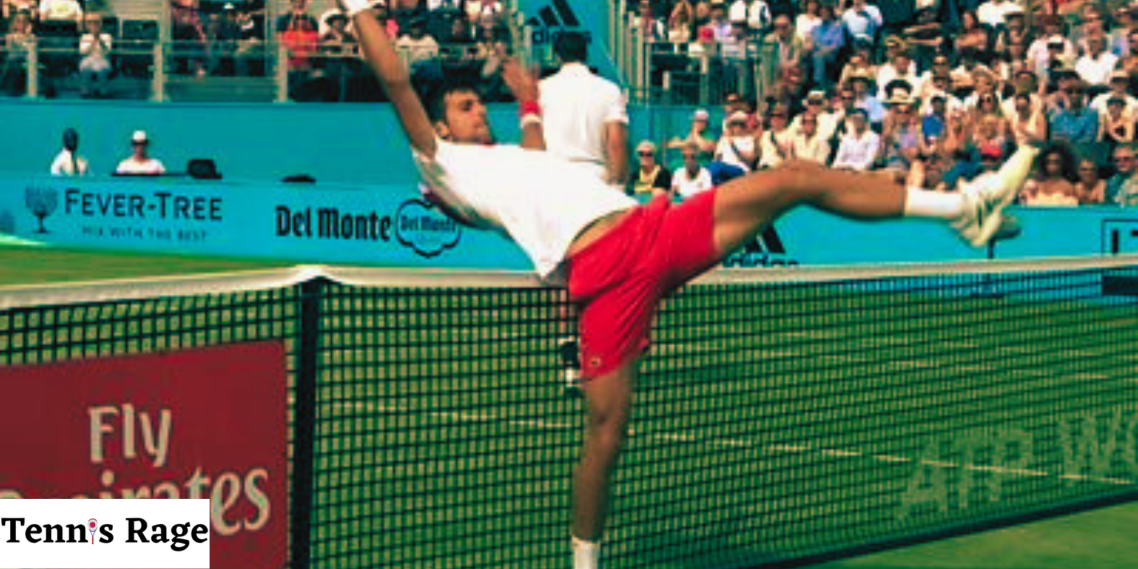Tennis players love to discuss the rules regarding crossing or touching the net, as well as debate different hypothetical scenarios such as whether a player is allowed to actually jump over the net during a point.
As discussed in a previous article, the rules of tennis are governed by the International Tennis Federation. The rules regarding whether players can cross or touch the net are covered by Rule 24.
Can A Player’s Racquet Touch or Cross Over The Net?
Rule 24(g) clearly states that the player or the player’s racquet, clothing or anything else the player is wearing or carrying cannot touch the net, or any part of the net including the posts or cables, while the ball is in play. If a player does touch the net while the ball is in play, the player loses the point.
The ITF Rules even provides several different examples to illustrate these rules. Here is the first example:
Case 1: After the server has served a first service, the racket falls out of the server’s hand and touches the net before the ball has bounced. Is this a service fault, or does the server lose the point?
Decision: The server loses the point because the racket touches the net while the ball is in play.
Further, Rule 24(h) explains that a player is only allowed to hit the ball after it crosses over to his or her side of the net. If a player hits the ball before it crosses over to his or her side of the net, the player loses the point.
The rules, therefore, allow a player’s racquet, after the ball is struck, to cross over the net to the opponent’s side of the court as long as the net is not touched.
Can A Player Hit a Shot Around The Net?
Similarly, a player’s shot is allowed to go around the net (and not over the net). Here is a wonderful example of such a shot by Roger Federer in a US Open match against Nick Kyrgios.
What happens if the ball bounces on a player’s side of the net and then bounces back to the other side? Can the player go to the other side of the net to hit the ball? The answer is yes, this is legal, provided the player does not touch the other side of the court while the ball is in play. Rule 24(g) explains that a player may not touch “the opponent’s court at any time while the ball is in play.”
While this is an extremely rare occurrence, a player is allowed to cross over to the other side of the net as long as he or she doesn’t touch the opponent’s side of the court while the ball is in play. Here is a great example of this at last year’s Australian Open by Pablo Carreno Busta in a match against Tallon Griekspoor.
You can see in the video that Carreno Busta steps on the doubles line of Griekspoor’s court. However, because this was a singles match, the doubles section is not considered part of the court.
Can A Player Jump Over The Net In The Middle Of A Point
As explained above, as long as a player hits the ball after it crosses over to his or her side of the net, the player’s body can go past the net as long as the net is not touched. Therefore, one might think that a player could theoretically jump over the net in the middle of a point and then run back to his or her side of the court to continue playing. While this might actually be theoretically possible, it is practically impossible because of Rule 24(g) which states that a player may not touch the opponent’s side of the court while the ball is in play.
Here is a video highlighting this rule at the 2016 Miami Open when Viktor Troicki actually jumped over the net in the middle of a point in a match against David Goffin.
As you can see in the video, the chair umpire called the point over and awarded the point to Goffin as soon as Troicki touched Goffin’s side of the court because of Rule 24(g) and because the ball was still “in play” as it had yet to bounce for a second time.
Had the ball bounced for a second time or touched Goffin’s body (which would have immediately ended the point as the ball would no longer be “in play”) prior to Troicki landing on Goffin’s side of the court, the point would have been awarded to Troicki.







